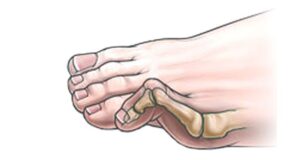HAMMER TOE
If you suffer from pain caused by Hammer toe, please Schedule an appointment with one of our orthopedic specialists as soon as possible.
 What is a Hammer Toe?
What is a Hammer Toe?
Orthopedic Foot and Ankle Specialists define “hammer toe” as a specific toe deformity in the second, third or fourth toes. With a hammer toe, the toe will bend upwards and curl downwards to look like a hammer. Early in the condition, patients will still retain the ability to bend the toe. However, patients will require surgery to regain movement of the toe if left untreated for too long.
Toe deformities can lead to further issues such as developing blisters or calluses from the constant rubbing on the other toes. In turn, the blisters and calluses can make walking with shoes incredibly painful. Patients may even experience joint pain in the deformed toes.
How do Specialists Treat Hammer Toes?
If patients can still flex the toe in question, our Orthopedic Foot and Ankle Specialists can help show them how to tape up or splint the toe to keep it held straight.
Non-steroidal Anti-inflammatory drugs such as ibuprofen and naproxen can help to relieve mild pain and swelling in the hammer toe. For severe pain and swelling, patients may require a physician to administer a steroid injection into the toe joint. For severe cases where the patient can no longer flex the deformed toe, the toe may require surgery to straighten the joint. Even so, physicians can usually perform such surgeries quickly, with only local anesthetic and patients can go home from the hospital the same day.
Hammer Toe Recovery

 What is a Hammer Toe?
What is a Hammer Toe?